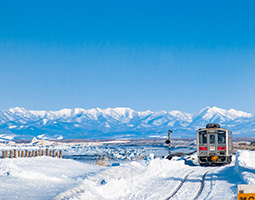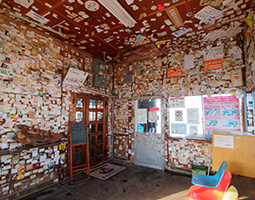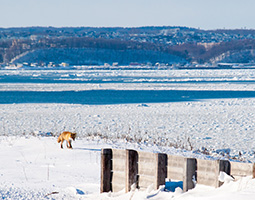February 2022
- English
- 日本語
The Closest Train Station to Drift Ice: Kitahama Station on the Senmo Line

Drift ice viewed from Kitahama Station 
Kitahama Station and observation deck (left)

The Shiretoko mountain range and a Senmo Line train 
Business cards and tickets cover the walls and ceiling of the station waiting room 
A fox walks alongside the drift ice near Kitahama Station

Kitahama Station, located in the northeast region of Hokkaido facing the Sea of Okhotsk, is a popular place to experience drift ice.

Kitahama Station in Abashiri City faces the Sea of Okhotsk in northeast Hokkaido, the northernmost of Japan’s four main islands. It is known as the station closest to drift ice and is one of Hokkaido’s most popular winter spots.
The Sea of Okhotsk stretches down to 45 degrees North latitude, the lowest latitude for seasonal sea ice formation in the world. The peak drift ice season occurs in late February to early March, when the whole of the sea is covered with ice floes.
Kitahama Station on the JR Hokkaido (Hokkaido Railway Company) Senmo Line is a wooden station building located just 20 meters from where the Sea of Okhotsk breaks on the shore. From the moment passengers get off from the train and stand on the platform, they are met with a panoramic view of the sea. Depending on the time of year, drift ice may be seen. The sea can also be viewed from the window of the waiting room. Visitors can walk from the station to the beach, where they can actually touch the drift ice and listen to the ryuhyo nari, the creaking sound of the ice floes pushing against each other. Right next to the station building is an observatory deck offering a view of the sea from up high.

“When the drift ice arrives, the sea turns pure white all the way to the horizon and in the distance you can see the Shiretoko mountain range, which is a World Natural Heritage site. The view from Kitahama Station is a magnificent spectacle you won’t see anywhere else in the world.”
So says Hayakawa Junichi, head of the Hokkaido branch of the Tetsudo Tomo no Kai (Japan Railfan Club), a nationwide organization of railway enthusiasts with a history of over sixty years. The JR Hokkaido Senmo Line is 166.2 kilometers long. Starting from Abashiri City, it runs along the coast of the Sea of Okhotsk for around 40 kilometers, then southward through Akan-Mashu National Park and Kushiroshitsugen National Park, registered as wetlands under the Ramsar Convention, and ending at Kushiro City on the Pacific coast. Kitahama Station was opened in 1924, but with the development of road transportation networks and a fall in population, passenger numbers started to decline and by 1984 it had become an unmanned train station.
According to Hayakawa, however, it was around that time that Kitahama Station started to become more popular. Before the station became unmanned, the stationmaster at the time had placed a notebook in the station waiting room for visitors to write down their memories of their trip, and purchasers of a “platform ticket” that only allowed them to enter the station precincts were given a shell from the beach as a “pass.” The station’s reputation for its unique customer service gradually spread. Its growing popularity was also helped by its role as a filming location for numerous movies and TV dramas from the 1960s onward. In particular, the station was used in the filming of the 2008 Chinese hit movie If You Are the One, after which many tourists from China visited.
Visitors’ business cards and the tickets they purchased are stuck to the walls and ceiling of the waiting room at Kitahama Station. The room is full of the thoughts and feelings of those who traveled specially to Kitahama Station. The station’s office in the unmanned station building was remodeled to create the Café Teishaba (teishaba means station), which opened in 1986 and serves dishes using plenty of local seafood in a retro atmosphere created by using old train seats and other vintage items. The café is said to be popular with local people as well as tourists.

Says Hayakawa, “The Senmo Line has a clear view of the Sea of Okhotsk, and the bright blue of the sea and sky, known as Okhotsk Blue, fills the train windows. While visitors can enjoy the unique spectacle of the drift ice in winter, at other times of year they can take in picturesque scenery from the train, such as meadows full of flowers in early summer and beautiful lakes where swans gather. So I’d urge people to visit Kitahama Station by train rather than by car,” says Hayakawa.

Hokkaido in February and March is bitterly cold. But the cold makes the view from Kitahama Station of the sea covered with drift ice all the more captivating to those who visit.

